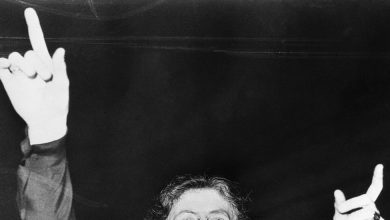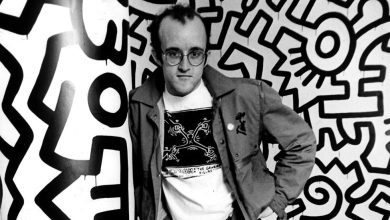Lin-Manuel Miranda on Writing Lyrics in Spanish and the Heartbreak of ‘Dos Oruguitas’

It was just one of those Tuesdays for Lin-Manuel Miranda. The composer, lyricist and actor — known for “In the Heights” and “Hamilton” — had trouble getting his youngest off to preschool, and his older son’s school bus was running late.
He sat down with his wife, the attorney and engineer Vanessa Nadal, just in time to catch the Oscar nominations. The real joy in watching, he said, was “how many friends I’m lucky enough to know that made such amazing work this year.”
He texted Ariana DeBose when she was nominated for best supporting actress for “West Side Story” and hit up the costume designer Paul Tazewell when he scored a nod for the same film. When Germaine Franco was recognized for best original score on the Disney animated film “Encanto,” which Miranda wrote songs for, he screamed for the whole neighborhood to hear.
“Encanto” follows Alma Madrigal, who fled her home years ago while escaping conflict. She saved her three infant children, but lost her husband, Pedro. Devastated, Alma clung to the candle she was using to light her way, which became enchanted — hence the “encanto” — and imbued her family members with magical powers, all except her grandchild Mirabel.
Miranda also received a nomination for the film: best original song for “Dos Oruguitas,” a heart-rending ballad at the emotional climax of “Encanto.” To top it off, the film — directed by Byron Howard and Jared Bush and co-directed by Charise Castro Smith — garnered a nomination for best animated feature.
Miranda, who lives in the Washington Heights neighborhood of New York, jogged across the George Washington Bridge and back in his excitement.
Although he has written his fair share of music — his “How Far I’ll Go” for Disney’s “Moana” picked up a best original song nomination in 2017 — “Dos Oruguitas” is the first song Miranda had written from start to finish in Spanish.
“I really went pretty far out of my comfort zone to write the tune, so I’m really just thrilled it’s been recognized,” he said. “It just makes you want to push more: lean into the things that scare you and do those things. That’s what’s worth doing, because that’s what makes you grow.”
These are edited excerpts from the conversation.
When did you write this song? What did that process look like?
It’s probably early last year, like March or April. But I remember the idea came on a brainstorm with Jared and Charise on the phone. Just sort of like, “I think the butterfly metaphor is already there visually. What if this song goes to nature’s original miracle?” And then, when I thought of the idea of two caterpillars in love, it was a wrap.
There’s so much that it was able to hold: both Abuela [Alma] and Pedro, and what the family is doing to each other by holding on too tight. I wanted it to feel like a song that always existed. All of my favorite folkloric songs all have nature metaphors embedded in them. I started dreaming in Spanish again while I was writing it. It was like my whole brain was trying to make it happen, even my subconscious.
Once you had that idea — caterpillars in love — were you able to write smoothly or did it take awhile to write in Spanish?
I think I wrote the first verse and chorus in, like, a week. Sent it to the creative team. They were all sniffling and they were like, “You’re on the right track; keep going.” I needed to reach for a poetic language that is beyond my standard conversational Spanish. I’m pretty fluent in conversational Spanish, but this needed to be elevated. I ran the grammar by my dad. And looked for the words that aren’t in my everyday usage: crisálidas [chrysalises], desorientadas [disoriented]. You do whatever you need to do to get the hook out.
Why did it feel like this song had to be in Spanish?
Because honestly, all of the words central to the metaphor are more beautiful in Spanish, on a technical level: oruguitas, crisálidas, mariposas [butterflies] are just beautiful words. But also I think there’s a subtle generational play happening with the way we use language in this movie: The younger siblings are all expressing themselves in pretty contemporary genres: reggaeton for Luisa, ’90s rock en español for Isabela [Mirabel’s sisters]. And so it felt like the matriarch of the family and the central, foundational story of this family and this miracle should be in Spanish.
How did you choose Sebastián Yatra — a younger, pop-y singer — to voice that sentiment?
We went back and forth initially over whether it was a female or male vocal. And we kind of felt like, “Well, if it’s female, it will feel like Abuela is singing it.” It didn’t feel quite right. I tell the story a lot, but a lot of writing the right song is figuring out what is not the right song. It didn’t feel right for Abuela to sing a song to Mirabel, full stop. So that’s what gets you to the male vocalist.
When we started working on this together — Jared, Charise, Byron and I — we all sort of made mixtapes for each other. We all did our own deep dives of Colombian music, and Sebastián just popped up in all our mixes. He’s got such a beautiful voice, and he’s around the age of Abuelo Pedro when the film takes place, so it’s just kind of a perfect fit.
What specific aspects of Colombian folk music inspired you?
First of all, the folkloric music we heard over there, which was so beautiful — basically anything with a tiple on it, I was kind of in love with. But then the other thing I really thought about was, “What are just the Latin songs that live forever?” I was thinking about “Guantanamera” and “Cielito Lindo.” I don’t feel like anyone ever wrote those songs. Although of course they all have incredible songwriters. I just feel like they always existed. So I really listened to those and the shape of them. The verse and chorus of it owes a lot to those hits.
The only other song that feels close to it in songs I’ve written is a snippet of a song called “Siempre” in “In the Heights,” where I wanted that to feel like a bolero that always existed. But again, that’s not a full song. It’s like a verse in the chorus for a record-scratch joke.
In the scene where we hear “Dos Oruguitas,” golden butterflies are everywhere, which evokes a favorite motif of the Colombian novelist Gabriel García Márquez. Did his butterflies inspire the metaphor in any way, or did they just happen to align once you found the caterpillar idea?
Absolutely. The song itself was absolutely inspired by the visual metaphor that the animation team was already playing with. That scene in all of its conception hadn’t existed yet, but I had seen the candle which turned into a butterfly. And that was the inspiration for going to that metaphor. So it’s also of a great example of how much collaboration happens in an animated movie. It’s like writing for theater to the nth power.
Like I write a rap section for Dolores in “We Don’t Talk About Bruno,” and the writers take that and ran that vibe for her throughout the movie, and in turn, the animation department thinks of this butterfly metaphor absolutely inspired by García Márquez. And then I get to run with that as a song idea. You know you’re cooking with gas when you’re all kind of feeding each other.
This song makes me cry every time. Did you cry at all while writing it?
Oh yeah. I always think of myself as Tita in “Como Agua Para Chocolate” [“Like Water For Chocolate”]: I cry in the recipe.
I thought about my first serious relationship and how we were two people who loved each other very much, but the world was bigger and we were going in different directions. I definitely went there in my heart while I was writing it. You pull on all of it. And also moments in your life when you were so scared of change, and you just have to trust that there’s a reason it’s happening. That, to me, strikes a deeper chord than even the themes as they appear in the movie itself.
This is your second Oscar nomination, and if you were to win, you’d become the 17th person to attain EGOT status. How does it feel?
On one level, it feels totally silly, because that is a term that got popularized by “30 Rock,” which is a hilarious thing for anyone to chase: that you’re chasing something Tracy Jordan chased.
But on another level, the thing that always feels special about this is that artists vote on it. My fellow moviemakers, my fellow songwriters, the music branch. I’ve met some of those folks, and they’re like the most incredibly, wildly intelligent folks who have made music that I love.




